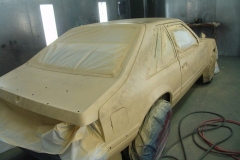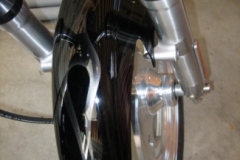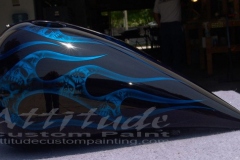



by acp ·
EPA has new requirements to reduce air pollution of metals such as chrome, lead, cadmium, manganese and nickel compounds, and also to reduce methylene chloride fumes, from autobody refinishing work.
Harley Parts For Sale SectionSee our section with both new and used parts including fenders, tanks, stretched baggers kits, used emblems along with RARE Harley-Davidson Items See the section here Search our websiteAuto Body StoreTools, equipment, paint and more. Recent Posts
 Outstanding quality repair & paint job on my Harley-Davidson gas tank, repaint on my front fender & inner fairing. Looks just like brand new factory paint! Scott is a master craftsman! He delivered beyond measure in matching the paint and style in the spirit of my 105th Anniversary Harley Heritage Softail. I highly recommend him and would use him again in a... heartbeat.read more I am absolutely THRILLED with my "new" car. Scott did an AMAZING paint job on my old Camry, it looks brandy NEW and even cleared the headlamp covers so they sparkle! AND, he did it in just a few days!!!! not... weeks like some of those others. PLEASE BRING YOUR BUSINESS TO AN INDEPENDENT BUSINESS OWNER, you will NOT be disappointed in Scott's work! This is a husband/wife business operating for over 20 years!!! KUDOS and Blessings to them :-)read more Best custom painter in town. Been using for years. Lots of experience with bikes and custom cars. This is Roberto and I am using my wife's email address.My 2008 Honda Civic is the Love of my life and my wife knows that. I am very particular about who works on my car and I scoured the Internet for the... best. It took me a long time to look for someone to paint my car. I chose Attitude Custom Painting because of Scott and Jody's top notch Customer Care. When I brought my car to their shop, Scott was Professional he advised to what is only required to be done to my car. I was impressed that he actually gave me a hard copy of estimate and no surprise hidden costs. The price is reasonable. Before I made my final decision, I called the shop numerous times because I've tons of concerns/questions. Understandably, my car is getting a major work done. When I call, Jody always picks up the phone. She was Professional and very patient with me. If Scott was not available at the moment, he will call back in a timely manner.Now, about the Paint job, all I can say is WOW! WOW! WOW!. Look no further and don't waste your time anywhere else because Attitude is the Place for the best Car Paint Job. It doesn't matter to him if you're driving an inexpensive or very expensive car, he will treat it with great care and attention.The flawless workmanship and quality are unmatchable. He truly is a Perfectionist. He even cleaned my headlights as complimentary. Thank you Scott and Jody for making my Girl looking like Brand New!read more I brought my 2014 Corvette in for a minor spot job to repair scratches that were too deep to just buff out. Scott was very accommodating as I dropped it off a little early, no problem. He started on it early... and had it done for me the next day. He did a perfect job matching and blending it just as if it was factory. Jody also stayed in touch with me to let me know what was going on with the job. I highly recommend their work and will be doing business with them again in the near future for my Classic car. Thanks again for knocking it out so quick and getting it done on short notice!read more This business is absolutely amazing. Scott and Jody were so accommodating and completely thorough with all of our needs. Scott went above and beyond and turned our truck into an absolute beauty. We are above... satisfied and would definitely utilize this business again. Highly recommend Attitude Custom Painting Inc...read more Scott at Attitude did an amazing job and even faster than expected. The tank and gauge cluster look better than new! Thank you!!!! As much as I hate to leave a review like this, I feel it’s necessary given my experience. I brought my GMC Yukon XL in to Scott, due to the factory paint being completely faded on the roof, and the hood was... full of scratches and swirls. I also had minor damage to the right side of bumper from the previous owner. I paid a lot of money for this vehicle and plan to keep it forever. With that being said, I wanted to invest in a new paint job. This company had awesome reviews and were super friendly and easy to work with when getting a quote and getting scheduled in for service. Scott and Jody seem like great, hard working people, which makes this review so much harder. I opted to upgrade to the high grade paint job Scott offers. When I picked my vehicle up it was gloomy and rainy. It looked good from what I could tell. A day later when the sun was shining I could see swirls everywhere. I also noticed solvent pop(patches of tiny bubbles) in multiple areas on the left side of the vehicle. I called Scott and he told me to bring it back and we scheduled a date and time to bring it back in. I felt it was nice that he would resolve the issue. In between that time I did wash my car as I was told it was okay to wash but to baby it since paint was still curing. When I washed it, a patch of clear coat literally started peeling off. So I brought it back and show all this to Scott, he tells me he will give me a call when truck is ready. He worked on it all day, wet sanded and buffed it I think. He repaired the clear coat peeling, and my truck looked nice and shiny. He even offered to pay $100 toward my first wax, which he did. However, here we are over a month later and I still have solvent pop in multiple places. There is also orange peel I was told will go away when paint cures. Hopefully it will, but it’s been over a month. While Scott’s prices are reasonable, and they are friendly, I’m not happy with my paint job. I feel I spent a lot of money and wanted a great job, hence why I upgraded to high end paint, and chose a shop with great reputation and reviews. I’m not hopeful in the longevity of the paint and hate feeling the way I do about the money I invested in it. At this point I’m going to live with it. Maybe this was a one time thing and it just happened to be my car.***RESPONSE to owner***I have no complaints about the hood as it’s honestly beautiful. The areas where there are bubbles, you did wet sand however they are still there. Orange peel is not minimal Scott. Also, thank you for correcting me on the side of the vehicle. There’s bubble spots all along that side of the vehicle. The video you took looks stunning. It looks clean and shiny. I’ll attach the photos of the up close blemishes. After I had my truck cleaned and waxed I took a look at the roof of the truck and that’s a whole other story. I thought when I originally brought it in prior to being painted that you stated you’d have to strip down the roof and hood due to the awful condition it was in. It is what it is, but if it was your own personal vehicle you wouldn’t feel satisfied with it. Good day.read more Scott and Jody were amazing to work with! Beautiful work done on my GMC and I couldn’t be happier. Super reasonable and friendly service with GREAT quality work. Thank you so much Scott!! I own a very expensive, high end, custom, twin turbo 2010 Camaro that is my pride and joy. I did all of the drivetrain custom work as well as the custom interior. I decided to install a ZL1 front clip and... wanted a custom paint job that would reflect a particular "look" I had envisioned in my mind. I also had a couple dings in the roof and driver door that needed to be repaired.A customer of mine told me to try Attitude Custom Painting for a reliable and professional painting service specializing in custom work, so I did. I took the car over to his shop and we talked about what I wanted. After seeing some of his awesome work, I was immediately sold on having him do my Camaro, so we scheduled the project.He did it on time and when he returned the car to me, I was stunned at the workmanship and quality of everything he did. The project turned out fantastic and to perfection! I highly recommend him to anyone needing custom painting and want it done right and on time. The guy is a genius at what he does! I'm very hard to please but he exceeded my expectations.I have since had him do more custom painting on my interior trim pieces that required very precise pinstriping and he always meets the challenge and expectations. Scott and his wife, Jody, are awesome people and are honest and have the highest integrity. Hard to find these days. They get my highest possible rating!!!!!read more I have a black Hyundai Elantra and I wanted a lime green fade from front to back...so the front is lime green and it fades to the black...the pearlized lime green is BEAUTIFUL!!!...Scott NAILED IT!!! ITS... BETTER THEN I COULD OF IMAGINED!! I get compliments all the time!! People stop and stare at my car!! I am 120% SATISFIED And I would recommend Attitude Custom Painting to ANYONE that wants their car painted!! Price was good, he got it done when promised, no added BS fees like alot of places try to do! HE'S HONEST, I LIKE THAT!! The office manager ( I think his wife) was VERY SWEET and professional!!read more I used Attitude Custom Painting to repaint my truck and do some minor body work and I'm very happy with the results. The price was fair and right in line with what other shops quoted me. Scott finished the... job in about 3 and a half days when other shops said it could take up to two weeks. The quality of the work appears to be excellent, and I like that they include photos of the job in progress so you can see that they didn't cut corners. Anytime I called they picked up immediately and were always friendly. You couldn't ask for better service.I highly recommend this business.read more Absolutely the best! Great couple, straight forward, very honest. The work done there is flawless. Make Attitude your first stop! Scott repaired some motorcycle parts for me and matched the paint (3 stage big blue pearl) perfectly. If you are looking for quality service and reasonable prices this is the place! Really glad I decided to get my motorcycle painted here! Scott was super professional, friendly and timely with his responses. The quality of work done by him and his team is amazing! I’m impressed with how... well they made my idea come to life and she is sparkling! Would 100% recommend anyone to come get their paint jobs done hereread more Scott, Jody and staff are the best! I've had several cars painted and repaired there with excellent results! Thank you so much for your attention to detail and making sure the job is done right! I took in my memphis shade fairing to get it paint matched, they did an amazing job! They also had the best price out of everyone ! I love this custom paint shop they redone my gas tank for my 99 Yamaha V Star color match was perfect Jodi and Scott were excellent to work with I'm going to be doing future work with them on my vintage... Corvetteread more I had Scott completely repaint my 1983 Jeep Scrambler. The quality of work is excellent. The price he quoted was very competitive and he did not hit me up for unexpected extras. We did make a couple of minor... changes during the process and he was more than fair on the charges. Was very timely in getting the work done and kept me up to date on status (with pictures). I would definitely use him again and recommendread more Scott and Jody are great! Reasonably priced custom job on my Jeep Wrangler turned out wonderful. Would definitely get work done here again. I appreciated the opportunity and service. The shop helped me out. And I also enjoyed the shop settings. really professional and straight forward on anything 😉. Thanks 1999 Hayubusta. Candy metal flakes. Simply the best. All around hands down. I can’t wait to ride. I had my HD FatBoy painted it came out perfect, Scott exceeded my expectations on price & quality pleasure to do business with , highly recommend. Had my wife's 2018 H-D Softail Street Bob custom painted. The paint job turned out flawless and looks incredible. Pricing is very reasonable for a custom paint job. Scott and Jody at Attitude Custom Painting... are awesome to work with. They are very responsive and professional. Would definitely do business with again without hesitation.read more Top notch operation. First off, they always answer the phone and take the time to walk you through the work being done. Want an update? Give them a call and someone will tell you exactly what step in the... process is being done. I took a very curvaceous Ducati tank in with a fist size crash dent. They took the tank same day and gave a very reasonable 5 day estimate and got it done in that time . Scott repaired the dent and resprayed the tank for me. The paint shines better than new. Bonus: they’re actually nice and personable unlike the grease monkeys I usually deal with.read more After researching top notch painters in the Tampa Bay area, I chose to use Attitude Custom Painting. I met with Scott and his wife Jody and explained exactly what I was wanting him to do for me. I brought him... all my Harley Davidson Street Glide custom parts after meeting with them. My fiancé and I explained how important it was to us that this paint job needed to be perfect. When the work was completed, in a timely manner, Scott had us come to the shop to inspect and pick up all parts. I have to say we were absolutely ecstatic with the custom paint job! Scott knocked it out of the ball park and exceeded our expectations. We can’t thank you enough Scott and Jody for your professionalism and fantastic customer service. I highly recommend Attitude Custom Painting for the paint job you may be wanting.Thank you,Bart and Daniread more Brought my 2009 Jeep Wrangler to Attitude after getting hood replaced tohave complete vehicle painted.The rest of body had pits in paint as well as rust around door edges, Scott made the whole vehicle come... to life with a better than new car showroom finish(chose Midgrade paint package).There is a amazing attention to detail that provides exceptional value (applied lacquer to running boards and mirrors).You will get your money's worth and be pleased using Scott & Attitude.read more Had my Accord repainted here a few years back. They did an absolutely phenomenal job. I hate having others do work on my cars or my house. I am very critical of the work I do and hate paying to have others... to make mistakes. They were the rare case of perfection. My car had a better paint job when they were done than when it was new! Oh, and get this... Their price was very reasonable! Now I have been playing with the idea of changing the color on my Honda S2000. Wouldn't go anywhere else. 10 stars, if that is even possible...read more Archives |
Comments